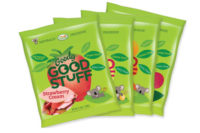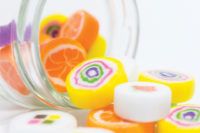By now, the push for cleaner labels and healthier food is hardly a surprise.
With the constant threat of a national debate about the apparently unhealthy connotations of eating candy, more and more emphasis is being placed on natural ingredients by both candy makers and consumers alike. Luckily, in today’s evolving industry, there are many ways to give sweet treats a healthy spin.
One of the most obvious answers, perhaps, is fruit. Not only are fruits tasty and naturally suited for pairing with candy, but they’re also universally accepted as a healthy and necessary part of people’s diets.
Many fruits are versatile ingredients that can be used in any number of ways, from being enrobed in chocolate to filling fruit-filled jellies and making crushed berry fillings. They’re also available in all forms, including dried, powders, fibers, concentrates and purees.
“The many innovative blueberry formats today have expanded the horizons of what is possible,” says Jeannette Ferrary, account executive for the U.S. Highbush Blueberry Council.
Not to mention that a blueberry sweet can also provide a full fruit serving. After all, one-fourth cup of dried fruit is all it takes to fill a serving, and consumers are eager to have them because they equate blueberries with antioxidants, says Ferrary.
But there are always innovations to balance out the classic ingredients.
Cargill’s Zerose erythritol is one such innovation, having recently undergone a three-year clinical study to prove its health benefits.
The study, conducted by the University of Tartu’s Department of Stomatology, followed more than 400 elementary school children over the three-year period, during which erythritol was compared with other polyol candies.
The students who had erythritol showed the most reduction in cavity development compared to students who had xylitol and sorbitol, says Pam Stauffer, global marketing programs manager, Cargill.
Not to mention, erythritol is a functional, sensory ingredient that delivers zero calories, a clean taste and a cooling effect. It’s particularly useful in mint-flavored candy, although it has been applied to chewing gum, hard candies, lozenges and chocolate.
“Erythritol is the only polyol which allows a greater-than-30 percent calorie reduction in chocolate,” says Ravi Nana, polyols technical service manager, Cargill. “As compared to most polyols, erythritol also makes higher conching temperatures possible, resulting in an enhanced flavor development.”
On top of allowing more advanced flavor development and better oral health, erythritol is also an important sugar alternative.
“Consumers have become more conscious of the amount of sugar they consume, yet taste remains the top priority,” says Stauffer. “Zerose erythritol can help to reduce sugar and calories in products while delivering taste and functionality similar to sugar, such as a clean sweet taste and unique cooling effect.”
Other similar additives with healthy twists include Jungbunzlauer’s Erylite Stevia, a natural sweetening system, and sub4salt, a mineral salt blend that reduces sodium content by up to 50 percent while maintaining the functionality of regular salt.
“Consumers are looking for additives that are normally found in other food products,” says John Reidy, market development manager, health and nutrition, Jungbunzlauer. “They want mineral fortification, reduced sugar or natural alternatives to synthetic ingredients.”
Jungbunzlauer’s additives help do all of those things, reducing sugar and sodium with naturally based ingredients.
“I believe the gummy craze in the supplement industry started to get people used to the idea that a candy-like product could contain some healthy benefit as well,” says Reidy. “These health-conscious people would like to see healthy options for their favorite candy, so they don’t feel guilty eating it.”
And additives like collagen peptide, which has been popular in Japanese candy for several years and is spreading into other markets, can provide multiple health benefits as well.
“More and more people are seeking out products that can help them with specific health issues,” says Caroline Brochard-Garnier, communication manager, Rousselot.
Thanks to the diverse range of benefits collagen peptide offers, manufacturers can create products to target specific sectors, such as the nutricosmetic and healthy aging markets. That’s because collagen peptides can help not only with skin beauty, but they can be used in combination with other ingredients to make candies that promote bone health.
“Collagen peptides can be used to create functional candies that can form part of healthy eating habits to prevent the onset of osteopenia and osteoarthritis,” says Brochard-Garnier. “As well as reducing the painful symptoms that can occur with these conditions.”
It’s a way for manufacturers to differentiate their products, creating exciting new functional treats that serve a healthy purpose. Which only goes to show that, despite higher standards for healthy treats, there’s no shortage of ways to go about adding that halo of health to any sweet.









